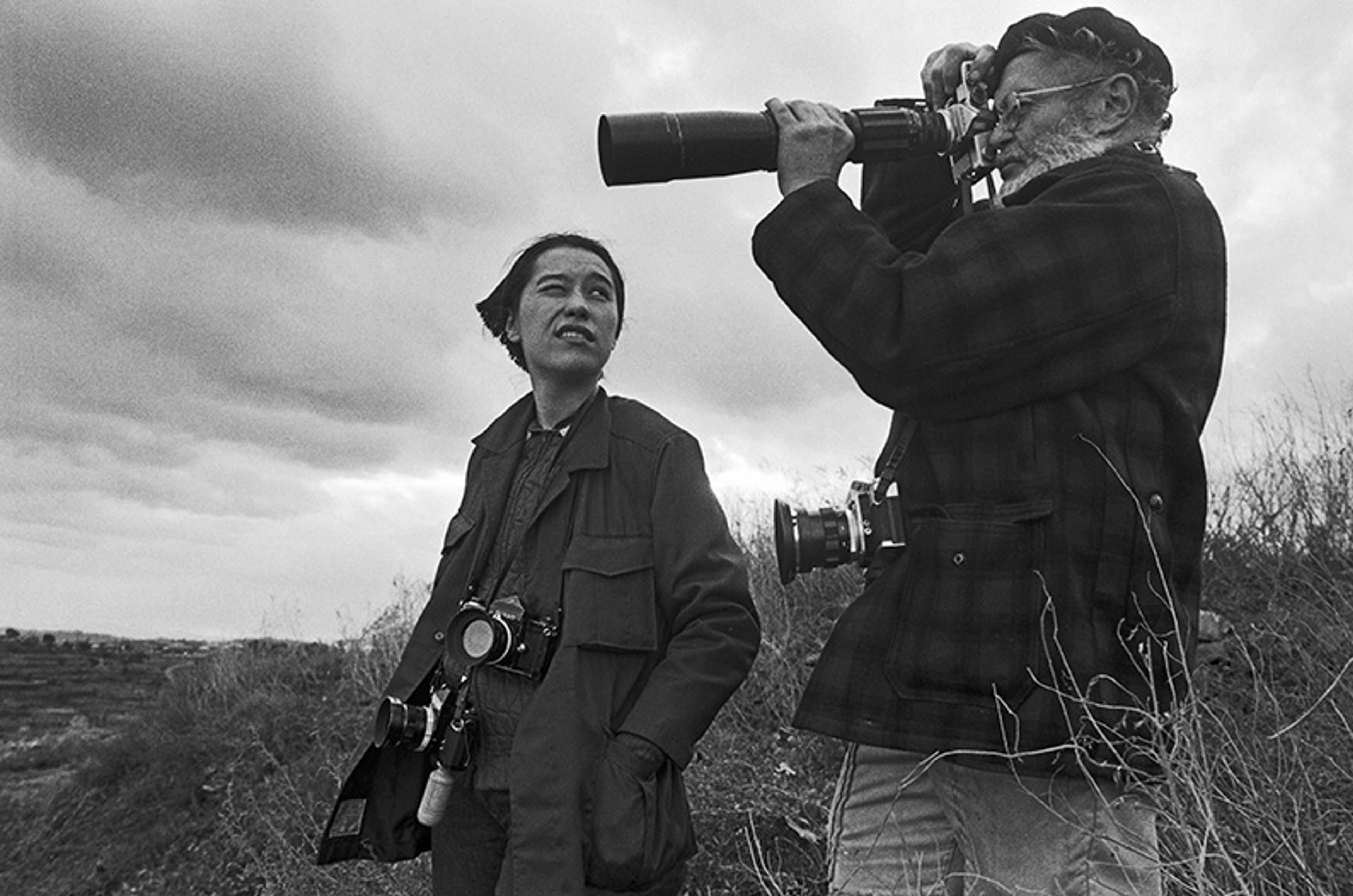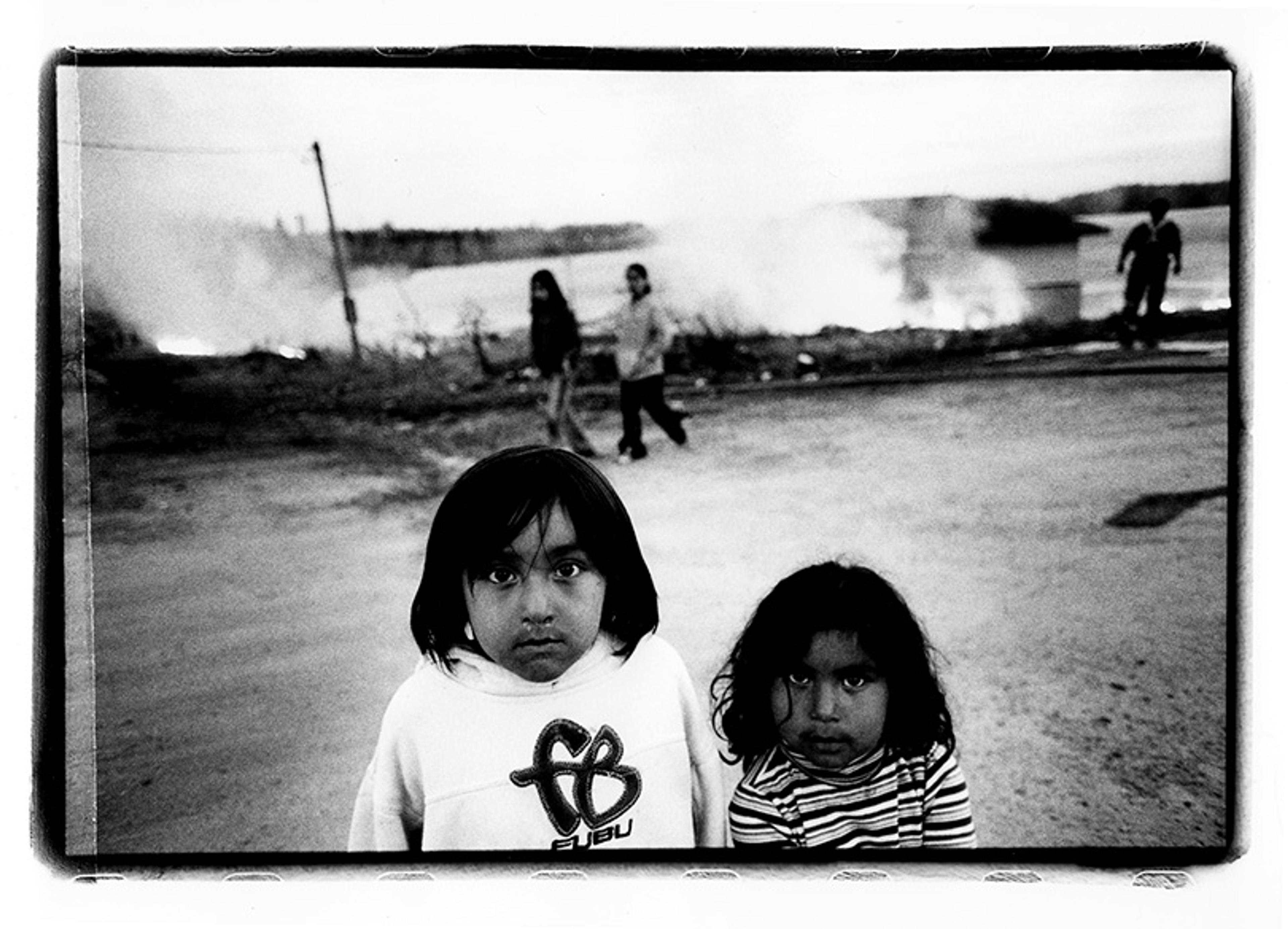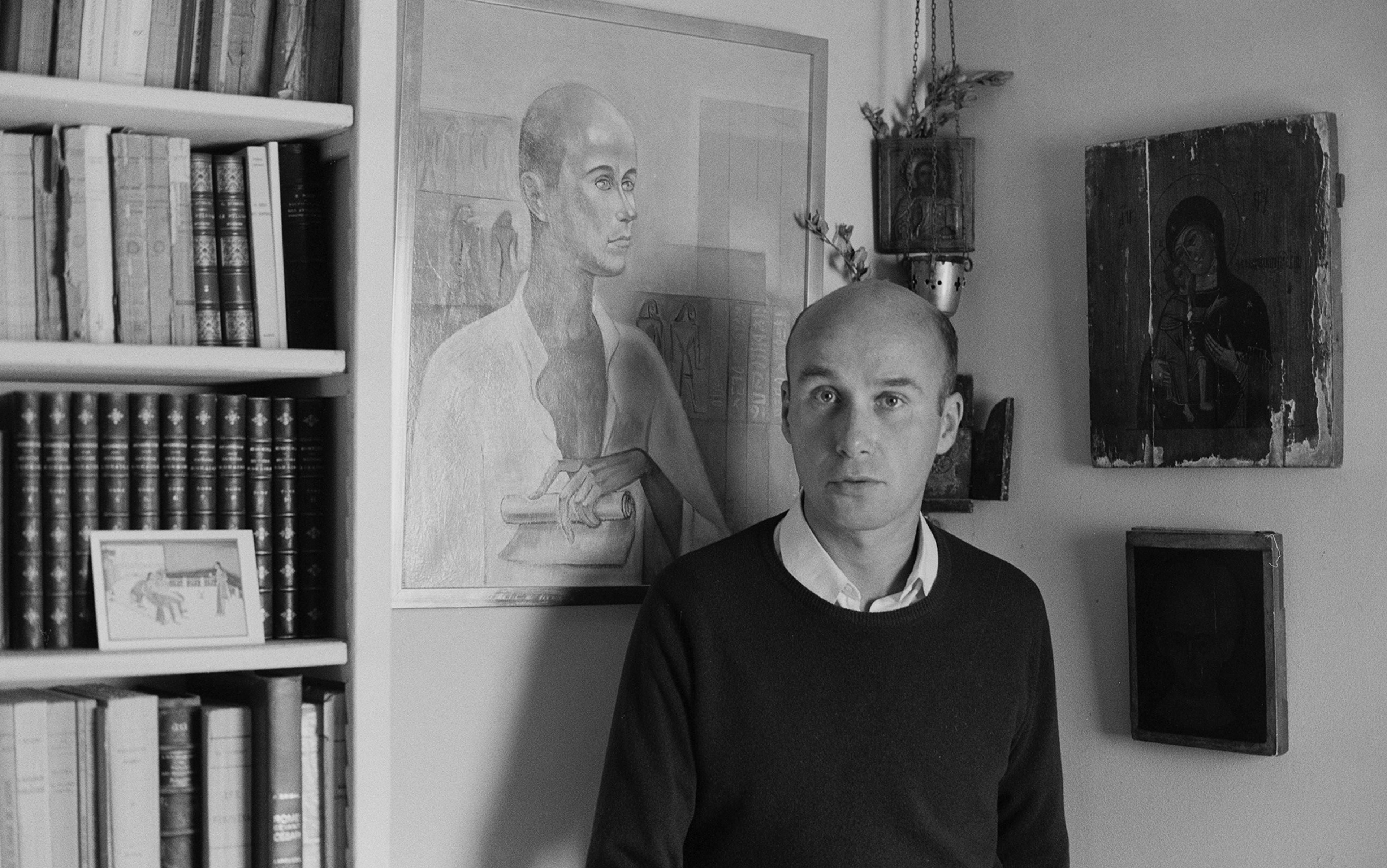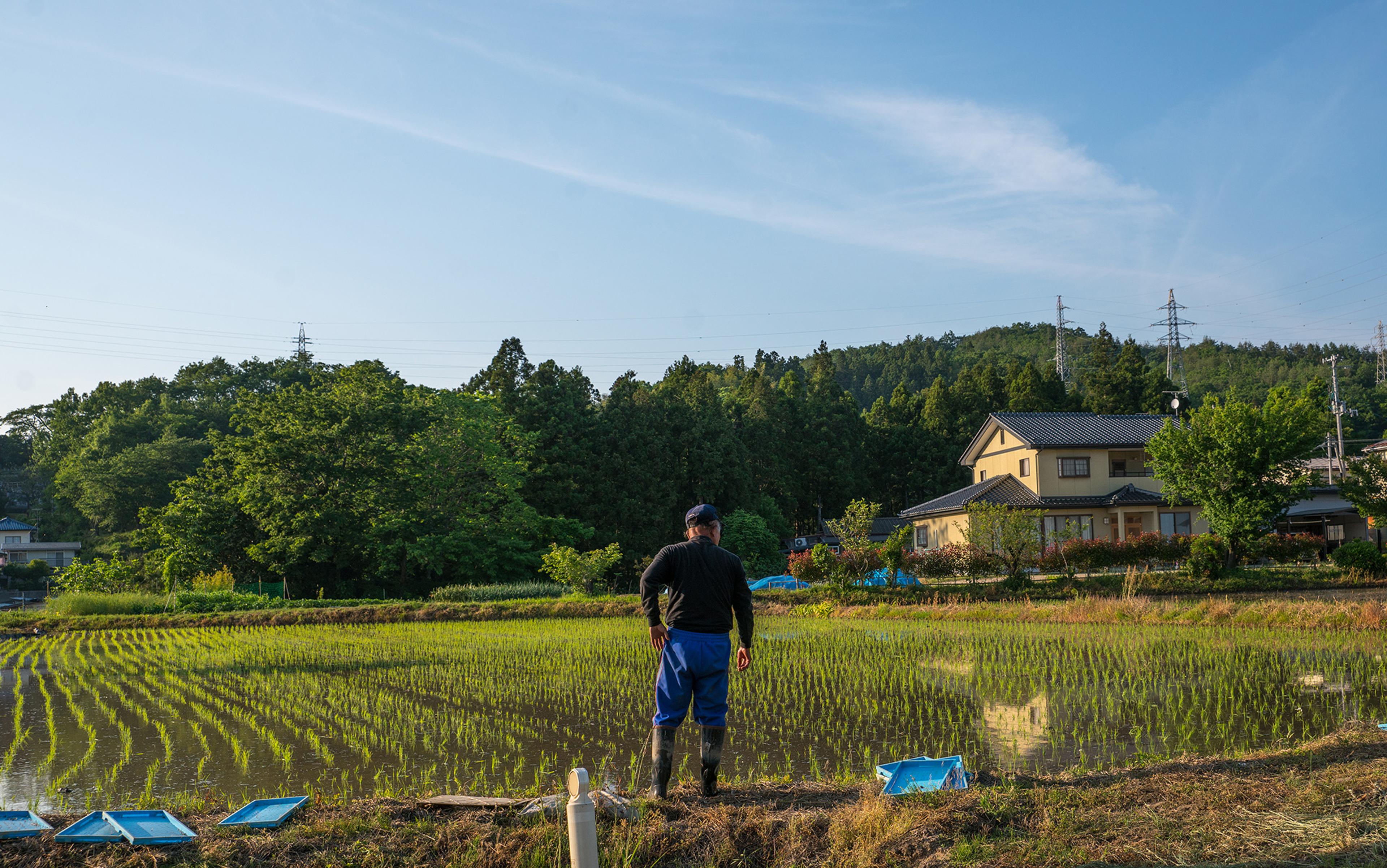There is a moment in my life that marks a split between a ‘before’ and an ‘after’. I was around 12 years old, sitting cross-legged on the cream carpet in my family’s living room in Ottawa when I opened a large, heavy book, awkward in my skinny arms. The texture of the paper was strange: it was matt, a word I didn’t know then. The ink was blacker than anything I had seen. A pure void – no light, no reflection, nothing. My fingers left small shiny traces on the paper, which took a few seconds to disappear. My child’s mind could not understand what it was seeing.
Bodies. Contortions. Something was very wrong. Humans who had been put together incorrectly, limbs sticking out at odd angles, crumpled like broken birds’ wings, like snapped twigs.
I kept looking, trying to make sense of these photographs.
Pipes discharging wastewater into a black sea.
Schools of fish. Boats with men and women hauling bulging nets onto the decks.
A sparkling factory, its lights like stars in a black sky. It looked like a spaceship.
I was staring into my father’s copy of Minamata (1975), W Eugene Smith and Aileen M Smith’s masterpiece of photojournalism with accompanying essays. It was published three years after the Smiths’ photo essay ‘Death-Flow from a Pipe’ had appeared in Life magazine. Eugene Smith and his then-wife Aileen had spent three years in the small fishing village of Minamata in Japan documenting the effects of mercury poisoning by the Japanese Chisso Corporation for the purposes of their essay, which was expanded to become the hefty Minamata.

Aileen M Smith and W Eugene Smith in Minimata. Photo © Takeshi Ishikawa
About halfway through the book, I came across the photo that truly claimed me, spread across two pages.
The left is almost all black. We are in a small room; the photographer must also be in the room as the figures are so close to us. On the right-hand page, a woman holds the rigid body of a teenager. The teenager is naked. All we can make out is her three-quarter profile, eyes rolled upwards, her teeth showing through a slightly opened mouth, her skinny torso, ribs, deformed hands hovering in the air; one knee resting on her mother’s wrist, the other hovering. Her thick black hair flops back from her forehead. You can almost feel the steam filling the room like hot breath.
This photo, ‘Tomoko and Mother in the Bath’ by Eugene Smith, triggered something profound that I have never been able to shake or even fully comprehend. Why this image? Why did it penetrate so deeply? The effect it had on me has something to do with the fact that it was pure accident that led me to it; the photo found me, rather than the other way round. By discovering it in one of my father’s books, I felt I had stumbled upon a secret, something I wasn’t meant to see. The pain captured in this photo – and captured so humanely – was something that I, a child of the Canadian suburbs, had never seen. This kind of before-and-after moment is expressed by Susan Sontag in her book On Photography (1977). Her ‘first encounter with the photographic inventory of ultimate horror’, she tells us, was ‘a kind of revelation’. It was photos of Bergen-Belsen and Dachau that she came across by chance in a bookstore in Santa Monica in July 1945 that broke her. ‘Nothing I have seen – in photographs or in real life – ever cut me as sharply, deeply, instantaneously,’ she writes. ‘Indeed, it seems plausible to me to divide my life into two parts, before I saw those photographs (I was 12) and after.’
Seeing Tomoko’s young, contorted body was the moment I realised there was such a thing as horror and that those who are most affected are often victims of chance or fate. Here was a girl who, by dint of being born in Minamata rather than Ottawa, had been poisoned. All these years later, I am unnerved by the fact that Tomoko’s appearance was so unlike a healthy teenager that Sontag, writing about this very picture, could not make out that she was female, and referred instead to ‘Smith’s photograph of a dying youth writhing on his [sic] mother’s lap’. The youth was not male nor was she dying – she lived another five years. The composition of this photo echoes the classic pose of the Virgin Mary holding a dying Christ. Sontag sees it as a ‘Pietà for the world of plague victims’. Tomoko died for us all, is the subtext here – but it is important to note that she did not die from an uncontainable virus. She died because of a human-made environmental catastrophe.

Michelangelo’s Pietà in St Peter’s Basilica in the Vatican. Courtesy Wikipedia
From 1932 to 1968, the Chisso Corporation dumped methylmercury-laced wastewater into Minamata Bay. From the mid-1940s, a ‘strange disease’ started to appear in town. At first, the symptoms – seizures, loss of motor control, numbness, paralysis, sensory impairment and death within weeks, months or years from the first signs of illness – were described anecdotally. However, in 1957, a Chisso Corporation doctor gave it a name: Minamata disease. Babies were born deformed, blind and with a range of disabilities as the mercury passed through their mother’s placenta. Sometimes, the unborn baby acted as a sponge for the toxin, leaving some mothers without symptoms. This was the case for Tomoko Kamimura. Her family called her their ‘treasure child’ because she spared her mother from the disease.
Just as in fairy tales, the poison gets out, it spreads; there is always a story in its wake
For years, the Chisso Corporation would not accept any correlation between its industrial waste and Minamata disease. Yet this connection made so much sense – even to my child’s mind: you poison the water, the fish end up toxic. People eat the fish, they get sick. How could it have taken so many years and a lengthy photographic exposé to join the dots? The Smiths’ 1972 photo essay in Life drew global attention to the issue of mercury poisoning. Their photographs played a huge part in Chisso accepting responsibility and paying compensation to those affected by the disease. By 2004, the corporation had paid out $86 million to claimants. The company was also ordered to ‘clean up’ the contamination. But the thing with water is that you can’t clean it up. Once the poison is there, it never goes away. All you can do is stop eating the fish.
I don’t remember going beyond the photo of Tomoko when I pored over Minamata as a child. But I do remember the feeling I had as I closed the book: I knew, I just knew in my bones, that Minamata wasn’t really very far away, and that poison – like horror – doesn’t observe boundaries: it never stays in the pot. Just as in fairy tales, the poison gets out, it spreads; there is always a story in its wake. It wasn’t simply the content of that image that seared my memory, but the fact that someone had gone there to document it. This gets to the heart of the importance of the photographic enterprise. A photo like ‘Tomoko and Mother in the Bath’ exists because someone needed to take it.
An image has a provenance, a context and a history. The moment of a photograph’s inception is the moment a human has put themselves behind a camera to be a witness. The photographer’s intention is woven into the fabric of the photograph from its beginning. You could say that the decisions made on the part of the maker (where to stand, where to point the camera) are the source of an image, and its meaning flows from that source. Without that spark of intent, there would be no photograph. All of which is to say that one can feel the presence of Eugene Smith in the image of Tomoko – a presence unique to him, to his desire to enter that bathroom and show us that even intimate moments are not immune to being penetrated by the horrors of this world. In our drone-saturated, AI-infected, Photoshopped world, the maker is often lost or forgotten. Images labelled ‘content’ are deprived of context or meaning. We are daily bombarded with photographic images whose provenance we simply have no idea about, and whose intentions are often murky.
‘What good was served’ by seeing photos of camp survivors, Sontag asks? But perhaps an equally important question is: how were the subjects served by the reproduction and propagation of their image?
Eugene Smith believed he had two responsibilities: one to his subjects and one to his viewers. The story of ‘Tomoko and Mother in the Bath’ begins with Smith spending enough time with the Kamimuras for them to trust him during an intimate moment, followed by his hand clicking the shutter, but it does not end with the image on photographic paper or the deaths of the subject and the maker. When a French television company contacted the Kamimura family about a documentary they were making about the most important photographs of the 20th century, Yoshio Kamimura refused to be interviewed, stating that he wanted his daughter to ‘be laid to rest’.
A photograph emigrates from the territory of the present into the well of timelessness where art dwells
Aileen Smith had inherited the copyright to the image after Eugene’s death in 1978; when she heard of the family’s reaction, she travelled to Minamata and passed on the copyright to the Kamimuras. ‘This photograph would be a profanity if it continued to be issued against the will of Tomoko and her family,’ Aileen said. ‘The decision I made as holder of copyright to the photograph “Tomoko and Mother in the Bath” was … made after a great deal of deliberation, with love and care,’ she wrote – no doubt thinking about Eugene’s sense of responsibility to his subjects. Yoshio Kamimura could not alter the fate of his daughter, but he could decide how her image was used – if at all. As of 1998, 21 years after Tomoko’s death, it became against copyright to reproduce this photo, the one I have been carrying inside myself since I was a child. The Smiths knew the limits of the photographic image. ‘Photography is neither medicine nor god,’ Aileen wrote. ‘The photograph “Tomoko and Mother in the Bath”, in spite of its worldwide release, could not cure Tomoko’s illness.’
In its passage from ‘document of reality’ to ‘iconic work of art’ – a journey that often happens with the passage of time – a photograph emigrates from the territory of the present into the well of timelessness where art dwells. It’s a journey that can also drain an image of some of its potency. As an exercise in photographic time-travel, I think about aerial images of razed old-growth forests featuring lost-looking solitary orangutans, or unmanned drone images of ravaged war-torn cities, often described as ‘like something from a movie’. I imagine looking at them 50 years hence. Will some emigrate from ‘document’ or ‘reportage’ to ‘art’? Should they? Do we have a responsibility to prevent this alchemy or should we welcome it?
This is the paradox of the Pietà: although we may be broken by confronting horror, we also risk being comforted by the beauty of an image. But if we remember that someone went there to document it, perhaps we can bring some of the immediacy and potency back to an image. This act of returning authorship to a photograph cannot happen with the endless stream of images we scroll past on our phones. ‘Images transfix. Images anesthetize,’ Sontag writes when she describes how the shock of a photographic image ‘wears off with repeated viewings … making the horrible seem more ordinary – making it appear familiar, remote (“it’s only a photograph”), inevitable.’
Towards the end of 2023, I got the urge to revisit Minamata. I had no idea where my father’s first edition had gone after he died, so I asked my husband for a copy for Christmas. The one he got me was beautiful, but nothing like the original of my childhood. The pages were glossy, not matt, and its soft cover sat more comfortably in my arms. I started reading it in bed on Christmas day, when I fell ill with COVID-19. On page 138, I came upon Smith’s Pietà. This time, I knew it was coming, but I was still unprepared. I had shrunk down the image over the years in my memory until it was small enough to fit inside me. In the book, Ryoko and Tomoko’s surname is given as Uemura (a mistranslation by Eugene Smith from the Japanese). His text tells us that on the day of the court victory for victims affected by mercury poisoning, one newspaper ran the headline ‘The Day That Tomoko Smiled’. Smith adds with his trademark directness: ‘She couldn’t have cared less. She couldn’t possibly have known.’ And if Tomoko had been aware of the newspaper headline, it would have given her cold comfort. No compensation, however large, could make her healthy. Tomoko Kamimura died in 1977 at the age of 21. Eugene Smith died a year later, at 59.
When I was 12, I didn’t go beyond the photo of Tomoko. I stopped there and put the book down. But this Christmas I carried on. I turned the page and got a shock. What I had felt as a child, that what had happened in Minamata could happen anywhere – that horror could not be contained – was borne out. On the reverse of Smith’s Pietà was the startling heading: ‘Canada: Half a World Away’.
The Canadian section in Minamata about Grassy Narrows runs to a mere four pages. Grassy Narrows is a First Nation settlement about an hour’s drive from Kenora, in northwestern Ontario, the province I had grown up in. I knew of Kenora because it had been in the news back in the late 1970s and early ’80s. Also, around this time, one of my sisters started dating a member of the Kitigan Zibi Anishinabeg First Nation. I had visited his family on his reservation in upstate New York. He had a sister my age and we have remained in touch all these years. My sister married him and the issues around the government’s treatment of people I knew, who were now part of my family, became another source of grief and horror to my young self, linked now to the seed that had been planted in me by the Smiths’ photographic work.
Aileen Smith begins the Canadian section in Minamata by telling us that, two years previously, Gene had received a letter from some Ontario residents who were ‘fighting a lonely battle against mercury and destroying their main source of income in the process’. These people owned a tourist business along the English-Wabigoon River near Kenora. For centuries, this land had been prime hunting and fishing territory for the Grassy Narrows tribe, whose original name in the Ojibwe language is Asubpeeschoseewagong Netum Anishinabek, and whose history and culture are based around a profound and ongoing connection to the land – a land that now appeared to be poisoning them. Between 1962 and 1970, Dryden Chemicals (a Canadian subsidiary of the British multinational the Reed Paper Group Ltd) used mercury to make caustic soda and chlorine for bleaching their paper products. As part of the manufacturing process, they dumped more than 9,000 kg of mercury into the English-Wabigoon River upstream of the Grassy Narrows reserve.
It turns out that Minamata was far closer to me than I had been told, and yet somehow my child self knew this
The story in Grassy Narrows tragically echoes the story in Minamata. It would be comforting to think of this level of human and environmental devastation as something from the past, and yet how wrong this would be. There is little information out there about Ontario’s mercury-tainted water, but a 2017 Canadian Broadcasting Corporation (CBC) article by the journalist Jody Porter, who died in 2022, reported that ‘90 per cent of the population in Grassy Narrows experiences symptoms of mercury poisoning’, including ‘neurological problems ranging from numbness in fingers and toes to seizures and cognitive delays.’ Health services on the reserve consist of one small nursing station.

Grassy Narrows. Courtesy Howl Arts Collective/Flickr

Grassy Narrows. Courtesy Howl Arts Collective/Flickr
In 2014, the 17-year-old Calvin Kokopenace died from mercury poisoning in Grassy Narrows. His younger sister Azraya struggled with the loss, and in 2016 she sought help. Ontario police officers dropped her off at the Lake of the Woods District Hospital in Kenora. Two days later, her dead body was found nearby. Her family has been trying to get an autopsy report and an inquest but no one will give them the information they need to understand Azraya’s final hours. The 14-year-old has become another statistic in Canada’s long list of missing and murdered Indigenous women. It is such a common fate, that the acronym MMIW has a hashtag. Azraya’s friends believe her death was tied to despair over the loss of her brother. One of Azraya’s cousins, Chayna Loon, told the CBC: ‘Knowing how Calvin died, we could all be dying. We probably are, already, and we don’t know what’s going to happen because nobody is helping.’ It turns out that Minamata was far closer to me than I had been told, and yet somehow my child self knew this.
Back in the 1970s, the provincial government of Ontario told Grassy Narrows residents to stop eating fish, their main staple. Then all the commercial fisheries were shut down. Yet the Canadian government still refused to admit there was a problem. For years, Dryden Chemicals executives insisted there was no correlation between their plant and the presence of mercury in the water, despite the fact that fish caught near the mill showed much higher levels of mercury than fish caught further away. Private water-testers found levels of mercury in fish in the English-Wabigoon River to be as high as 27.8 parts per million (ppm). To give a sense of scale, the US Food and Drug Administration now says that the maximum safe level of mercury in seafood is 1 ppm. The Canadian government has since admitted that ‘some mercury levels in local fish were 30 times what was “acceptable”.’
The community’s staple food was now lethal, local jobs had disappeared, and Grassy Narrows went into decline. Suicide rates were high, as were cases of substance abuse. Because symptoms of Minamata disease can present in similar ways to the effects of alcohol poisoning, insult was added to injury by those in power who suggested that the symptoms they were seeing in the population were merely the signs of alcoholism. A 2020 article in The Lancet describes Grassy Narrows as being the epicentre of ‘one of the worst cases of environmental poisoning in Canadian history’. Despite this, a quick Google of nearby Kenora brings up this:
Take a cruise on Lake of the Woods on the MS Kenora or get your picture taken with Husky the Muskie, a 40 foot tall, 2-ton replica of a fish the lake is famous for. Kenora is known for its waterfront beauty and there are five major beaches in town.
A ‘muskie’ is the shortened form of muskellunge, a fish famous in Canada for its giant size. You can feed many people from a muskie. You could also potentially make them ill.
Steve Fobister, a former chief of the Grassy Narrows community and a campaigner for environmental justice, died in 2018 at the age of 66, just one year after Porter interviewed him for her CBC article. She wrote that Fobister ‘now has difficulty standing and swallowing … Even talking is a chore. It often requires him to hold his lower jaw with his thumb to reduce the shaking long enough to form words.’ The government still won’t admit that anyone at Grassy Narrows has been poisoned – only that some people ‘experience symptoms of Minamata disease’. Where is the person willing to go there and document it? Where is the Pietà for Grassy Narrows?
The Canadian photographer Edward Burtynsky does indeed photograph ecological devastation in Ontario, his home province, and beyond. However, his photos of mines, tailing ponds and blasted, poisoned landscapes depict the land without its people. Burtynsky turns ecological disaster into wall-size collectible images oozing terror and beauty. In the early 1980s, he stood on the edges of vast open pit mines across North America to show us the precipitous craters left behind from mining. His images are unsettling: tailing ponds sparkle like gemstones in Earth’s crust, deep-cut mining sites become geometric quilts. He later captured the patterned landscapes created by dryland farms in Spain from the open door of a helicopter. He goes higher again, photographing from a Cessna; and by 2021, he is using remote-controlled drones to photograph diseased olive trees in Puglia, soil erosion in Turkey and rare earth metal mining, among other ecologically devastating resource extraction. His trajectory from a hand-held camera to aerial drones is the trajectory of our times. His images are elegiac, abstract and aesthetically beautiful, and yet just below their surface they speak of devastation. Because of this, they sidestep the ‘paradox of the Pietà’. They fall fully formed into the well of art.
The problem with raising awareness of social or environmental issues, whether in the form of Smith’s emotionally charged Pietà or Burtynsky’s cool abstractions, is that, in order to ‘fix’ the problems, we would need to completely change the way we live, the way we think, do business, raise children, grow food, and live out our lives on the most granular level. Aggressive farming practices, the liberal application of pesticides, the proliferation of single-use plastics, disposable technologies requiring the extraction of metals, and a mindset of uncontained overconsumption mean that situations like Grassy Narrows will carry on.
Expecting a single photograph or photographer to change this is unfair. Sontag believed that: ‘The history of photography could be recapitulated as the struggle between two different imperatives: beautification, which comes from the fine arts, and truth-telling …’ She continues: ‘Like the post-romantic novelist and the reporter, the photographer was supposed to unmask hypocrisy and combat ignorance.’ I would add that when a photograph lands in the right hands, it can also plant a seed in a person’s deepest psyche. This sometimes comes at a personal cost not only to the subject, but to the photographer. Smith was badly beaten by Chisso’s hired security guards while photographing protesters in Japan. He suffered serious physical injuries that dogged him for the rest of his life. Nevertheless, he did go there and document it.
Since I started writing about Smith’s photo, I have noticed that my relationship to ‘Tomoko and Mother in the Bath’ has altered dramatically over the years. Where my childhood gaze was locked on Tomoko, my adult gaze now registers the presence of Tomoko’s mother. She, too, is naked and vulnerable in the bath with her daughter. Her expression is loving, concerned, peaceful, almost expectant, as if waiting for Tomoko to say something. Her downcast eyes are fixed on her daughter’s upturned face. What I hadn’t grasped then but now see so clearly is that those of us unaffected so directly by horror share something profound with Tomoko’s mother. We, too, are witnesses, and it is our job to hold the painful, suffering bodies left in the wake of devastation.
Seeing how horror can arrive unbidden on the doorstep of the innocent was the moment I lost my innocence. As a middle-aged woman, my gaze has shifted from the teenager to her mother. I’ve realised that is it she who holds the key. Maybe this is the most we can expect from an image of horror: that it asks us not to look away. It demands that we stay with it, and that we allow it to do its work within us: that we take on the gaze of Tomoko’s mother. Eugene Smith went there to document it; Life magazine brought his photo to the world. The rest is, and always has been, up to us.






